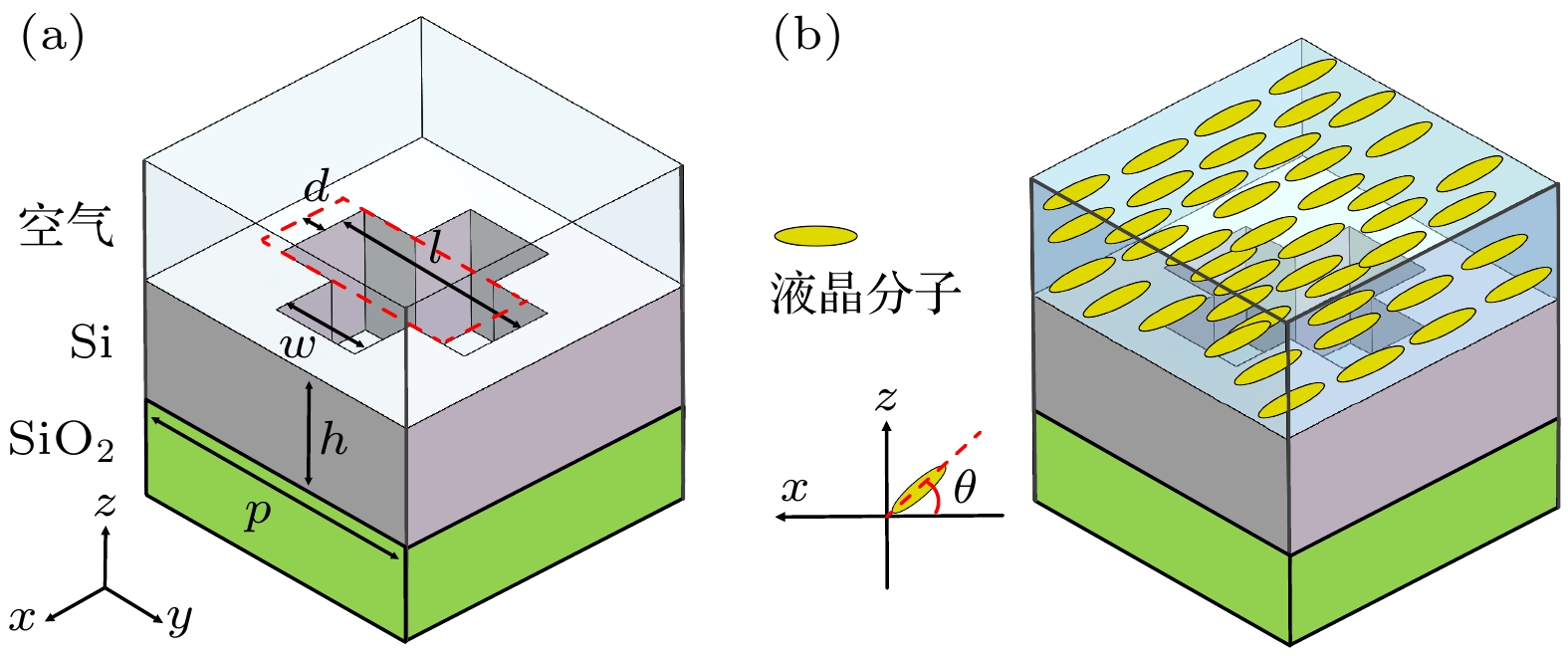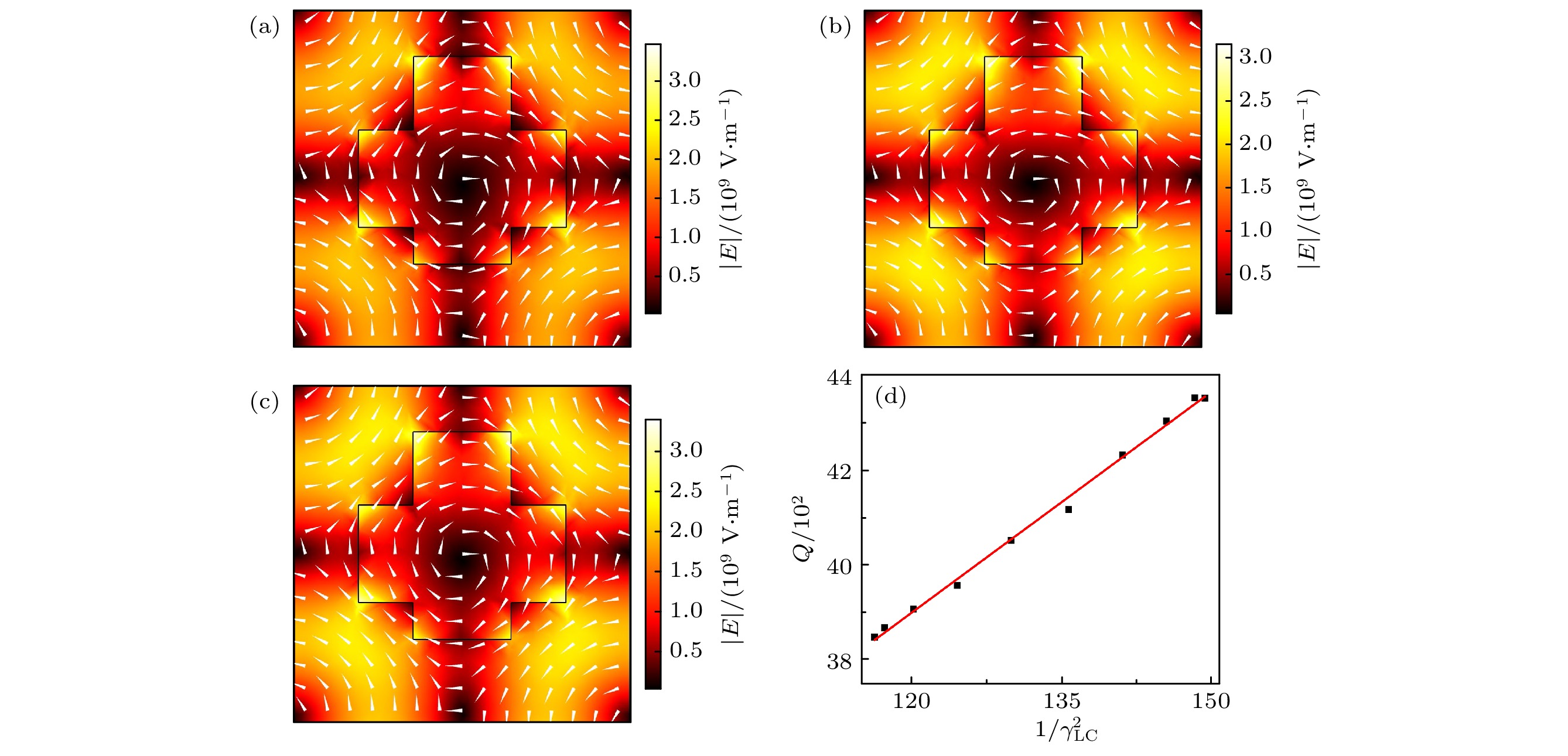-
与传统的光子晶体或超表面等微纳光学系统相比, 基于连续域束缚态(bound states in the continuum, BIC)的光学体系通常具有更高的品质因子(quality factor, Q)与更窄的工作线宽, 更高的Q值给高性能的光电元件提供了更广阔的可能性, 但是更窄的线宽往往给实际应用造成一定麻烦, 因为加工过程中的制造误差无可避免地导致实际的光学元件与理想情况存在差异, 表现为实际工作波长与理想工作波长不匹配. 为了克服该问题, 本文利用带十字结构孔的光子晶体产生的对称保护型准连续域束缚态(quasi-bound states in the continuum, q-BIC), 探索液晶(liquid crystal, LC)对q-BIC的动态调谐效应, 以补偿加工误差导致的工作波长偏移. 相比于入射光倾斜角对q-BIC的调制效应, 在移动相同的波长时, LC对系统的Q值影响更小, 例如使用入射光倾斜角调制q-BIC中心波长移动5.32 nm时, Q值下降75.84%, 而使用LC调制q-BIC中心波长移动5.63 nm时, Q值上升了14.27%, 这证明LC对高Q因子、超窄带的q-BIC元件具有极大的应用潜力. 最后讨论了LC在q-BIC体系中的工作机理, 可为广泛q-BIC的相关研究提供参考.Optical systems based on bound states in the continuum (BIC) generally possess higher quality factor (Q) values and narrower operational linewidths than traditional photonic crystals or metasurfaces. The higher Q values offer extensive possibilities for high-performance optoelectronic devices. However, the narrower linewidths often pose challenges in practical applications, as fabrication errors during production inevitably lead to discrepancies between real optical devices and their ideal designs, which results in mismatches between actual and ideal operating wavelengths. To solve this problem, we explore the dynamic tuning effect of liquid crystal (LC) on quasi-bound states in the continuum (q-BIC) so as to compensate for wavelength shifts caused by fabrication errors. A photonic crystal slab with cross-shaped holes serves as the platform for generating q-BIC. Compared with the modulation induced by the tilt angles of incident light on q-BIC, LC has a less influence on the system’s Q factor when the same operational wavelength is shifted. For instance, shifting the central wavelength λ0 of q-BIC by 5.32 nm by using a tilted incident angle results in the Q factor decreasing to 24.16% (from 3809.05 to 920.28). Whereas shifting the central wavelength λ0 by 5.63 nm through the tilt angle θ of LC leads Q factor to increase 14.27% (from 3809.05 to 4352.65). This demonstrates the significant potential of LC dynamic tuning in high-Q and ultra-narrowband q-BIC devices. Finally, the mechanism of LC within the q-BIC system is discussed. The smaller influence of LC on the Q factor is attributed to its minimal disruption of the q-BIC system’s symmetry. Although LC also affects system symmetry within the cross-shaped holes, after adjusting the asymmetry parameters of the system, the Q factor and the LC tuning process can be well matched. The results of our research provides valuable references for carrying on extensive research on q-BIC.
[1] Von Neumann J, Wigner E P 1929 Phys. Z. 30 467
[2] Hsu C W, Zhen B, Stone A D, Joannopoulos J D, Soljačić M 2016 Nat. Rev. Mater. 1 16048
 Google Scholar
Google Scholar
[3] Kang M, Liu T, Chan C T, Xiao M 2023 Nat. Rev. Phys. 5 659
 Google Scholar
Google Scholar
[4] Diao J Y, Han B X, Yin J, Li X J, Hong Z 2019 IEEE Photonics J. 11 4601110
[5] Huo Y Y, Zhang Y Q, Liu X Y, Ning T Y, Ren Y Y 2025 Opt. Commun. 574 131255
 Google Scholar
Google Scholar
[6] Franceschini P, Tognazzi A, Chernyak A M, et al. 2024 Nanophotonics 13 1
 Google Scholar
Google Scholar
[7] He W C, Wang Y S 2024 Opt. Express 32 39415
 Google Scholar
Google Scholar
[8] Ovcharenko A I, Blanchard C, Hugonin J P, Sauvan C 2020 Phys. Rev. B 101 155303
 Google Scholar
Google Scholar
[9] Krasikov S D, Bogdanov A A, Iorsh I V 2018 Phys. Rev. B 97 224309
 Google Scholar
Google Scholar
[10] Liang Y, Koshelev K, Zhang F C, Lin H, Lin S R, Wu J Y, Jia B H, Kivshar Y 2020 Nano Lett. 20 6351
 Google Scholar
Google Scholar
[11] Gorkunov M V, Antonov A A, Kivshar Y S 2020 Phys. Rev. Lett. 125 093903
 Google Scholar
Google Scholar
[12] Romano S, Zito G, Yépez SN L, Cabrini S, Penzo E, Coppola G, Rendina I, Mocellaark V 2019 Opt. Express 27 18776
 Google Scholar
Google Scholar
[13] Romano S, Zito G, Torino S, Calafiore G, Penzo E, Coppola G, Cabrini S, Rendina I, Mocella V 2018 Photon. Res. 6 726
 Google Scholar
Google Scholar
[14] Kodigala A, Lepetit T, Gu Q, Bahari B, Fainman Y, Kanté B 2017 Nature 541 196
 Google Scholar
Google Scholar
[15] Ha S T, Domínguez R P, Kuznetsov A I 2022 Adv. Opt. Mater. 10 2200753
 Google Scholar
Google Scholar
[16] Carletti L, Koshelev K, Angelis C D, Kivshar Y 2018 Phys. Rev. Lett. 121 033903
 Google Scholar
Google Scholar
[17] Kang L, Wu Y H, Ma X Z, Lan S F, Werner D H 2021 Adv. Opt. Mater. 10 2101497
[18] Kühne J, Wang J, Weber T, Kühner L, Maier S A, Tittl A 2021 Nanophotonics 10 4305
 Google Scholar
Google Scholar
[19] Li S Q, Xu X, Veetil R M, Valuckas V, Domínguez R P, Kuznetsov A I 2019 Science 364 1087
 Google Scholar
Google Scholar
[20] Zheng Z, Komar A, Kamali K Z, et al. 2021 J. Appl. Phys. 130 053105
 Google Scholar
Google Scholar
[21] Cui T, Bai B F, Sun H B 2019 Adv. Funct. Mater. 29 1806692
 Google Scholar
Google Scholar
[22] Badloe T, Lee J, Seong J, Rho J 2021 Adv. Photonics Res. 2 2000205
 Google Scholar
Google Scholar
[23] Xu S T, Fan J, Xue Z, Sun T, Li G, Li J, Lu D, Cong L 2024 Photonics Res. 12 2207
 Google Scholar
Google Scholar
[24] Yu B B, Yang F, Zeng M D, Meng X Y, Qian Z H, Tai Y H, Li T 2025 Adv. Funct. Mater. 35 2413098
 Google Scholar
Google Scholar
[25] Jain A, Moitra P, Koschny T, Valentine J, Soukoulis C M 2015 Adv. Opt. Mater. 3 1431
 Google Scholar
Google Scholar
[26] Dharmavarapu R, Izumi K, Katayama I, et al. 2019 Nanophotonics 8 1263
 Google Scholar
Google Scholar
[27] Komar A, Domínguez R P, Miroshnichenko A, et al. 2018 ACS Photonics 5 1742
 Google Scholar
Google Scholar
[28] Azzam S I, Chaudhuri K, Lagutchev A, et al. 2021 Laser Photonics Rev. 15 2000411
 Google Scholar
Google Scholar
[29] Zhang X, Zhao Z, Liu P, Ako RT, Sriram S, Zhao X, Liu H, Bu H 2024 Opt. Lett. 49 7016
 Google Scholar
Google Scholar
-
图 2 (a) 逐步改变d时光子晶体的透射谱; (b) Q因子与不对称参数γ的关系; (c) d = 60 nm, 光子晶体在空气环境与LC环境中的q-BIC
Fig. 2. (a) Transmission spectrum of the photonic crystal slab as the parameter d is gradually varied; (b) the relationship between Q factor and asymmetric parameter γ; (c) the q-BIC in air and LC environments when d = 60 nm.
图 3 d = 60 nm时 (a) LC分子倾斜角θ对q-BIC的影响; (b) 入射光倾斜角对q-BIC的影响; (c) 分别使用LC与入射光倾斜角调制q-BIC移动中心波长λ0时对应的Q值变化
Fig. 3. d = 60 nm: (a) The influence of the tilt angle θ of LC molecules on q-BIC; (b) the influence of the incident angle on q-BIC; (c) changes in the Q factor when modulating the λ0 of q-BIC using LC or incident angle.
图 4 d = 30 nm (a) LC分子倾斜角θ对q-BIC的影响; (b) 入射光倾斜角对q-BIC的影响; (c) 分别使用LC与入射光倾斜角调制q-BIC移动中心波长λ0时对应的Q值变化
Fig. 4. d = 30 nm: (a) Influence of the tilt angle θ of LC molecules on q-BIC; (b) influence of the incident angle on q-BIC; (c) changes in the Q factor when modulating the λ0 of q-BIC using LC or incident angle.
图 5 d = 30 nm (a) 光子晶体在空气中的电场分布, 箭头为xy平面内的电场方向; (b) 光子晶体在倾斜角θ = 0°的LC中的电场分布; (c) 光子晶体在倾斜角θ = 90°的LC中的电场分布; (d) LC调制过程中, 系统的Q值与修正后不对称参数γLC的关系
Fig. 5. (a)–(c) Electric field distribution when d = 30 nm, with arrows indicating the direction of the electric field in the xy plane; (a) in an air environment; (b) in LC with θ = 0°; (c) in LC with θ = 90°; (d) the relationship between the Q of the q-BIC and the modified asymmetry parameter γLC.
-
[1] Von Neumann J, Wigner E P 1929 Phys. Z. 30 467
[2] Hsu C W, Zhen B, Stone A D, Joannopoulos J D, Soljačić M 2016 Nat. Rev. Mater. 1 16048
 Google Scholar
Google Scholar
[3] Kang M, Liu T, Chan C T, Xiao M 2023 Nat. Rev. Phys. 5 659
 Google Scholar
Google Scholar
[4] Diao J Y, Han B X, Yin J, Li X J, Hong Z 2019 IEEE Photonics J. 11 4601110
[5] Huo Y Y, Zhang Y Q, Liu X Y, Ning T Y, Ren Y Y 2025 Opt. Commun. 574 131255
 Google Scholar
Google Scholar
[6] Franceschini P, Tognazzi A, Chernyak A M, et al. 2024 Nanophotonics 13 1
 Google Scholar
Google Scholar
[7] He W C, Wang Y S 2024 Opt. Express 32 39415
 Google Scholar
Google Scholar
[8] Ovcharenko A I, Blanchard C, Hugonin J P, Sauvan C 2020 Phys. Rev. B 101 155303
 Google Scholar
Google Scholar
[9] Krasikov S D, Bogdanov A A, Iorsh I V 2018 Phys. Rev. B 97 224309
 Google Scholar
Google Scholar
[10] Liang Y, Koshelev K, Zhang F C, Lin H, Lin S R, Wu J Y, Jia B H, Kivshar Y 2020 Nano Lett. 20 6351
 Google Scholar
Google Scholar
[11] Gorkunov M V, Antonov A A, Kivshar Y S 2020 Phys. Rev. Lett. 125 093903
 Google Scholar
Google Scholar
[12] Romano S, Zito G, Yépez SN L, Cabrini S, Penzo E, Coppola G, Rendina I, Mocellaark V 2019 Opt. Express 27 18776
 Google Scholar
Google Scholar
[13] Romano S, Zito G, Torino S, Calafiore G, Penzo E, Coppola G, Cabrini S, Rendina I, Mocella V 2018 Photon. Res. 6 726
 Google Scholar
Google Scholar
[14] Kodigala A, Lepetit T, Gu Q, Bahari B, Fainman Y, Kanté B 2017 Nature 541 196
 Google Scholar
Google Scholar
[15] Ha S T, Domínguez R P, Kuznetsov A I 2022 Adv. Opt. Mater. 10 2200753
 Google Scholar
Google Scholar
[16] Carletti L, Koshelev K, Angelis C D, Kivshar Y 2018 Phys. Rev. Lett. 121 033903
 Google Scholar
Google Scholar
[17] Kang L, Wu Y H, Ma X Z, Lan S F, Werner D H 2021 Adv. Opt. Mater. 10 2101497
[18] Kühne J, Wang J, Weber T, Kühner L, Maier S A, Tittl A 2021 Nanophotonics 10 4305
 Google Scholar
Google Scholar
[19] Li S Q, Xu X, Veetil R M, Valuckas V, Domínguez R P, Kuznetsov A I 2019 Science 364 1087
 Google Scholar
Google Scholar
[20] Zheng Z, Komar A, Kamali K Z, et al. 2021 J. Appl. Phys. 130 053105
 Google Scholar
Google Scholar
[21] Cui T, Bai B F, Sun H B 2019 Adv. Funct. Mater. 29 1806692
 Google Scholar
Google Scholar
[22] Badloe T, Lee J, Seong J, Rho J 2021 Adv. Photonics Res. 2 2000205
 Google Scholar
Google Scholar
[23] Xu S T, Fan J, Xue Z, Sun T, Li G, Li J, Lu D, Cong L 2024 Photonics Res. 12 2207
 Google Scholar
Google Scholar
[24] Yu B B, Yang F, Zeng M D, Meng X Y, Qian Z H, Tai Y H, Li T 2025 Adv. Funct. Mater. 35 2413098
 Google Scholar
Google Scholar
[25] Jain A, Moitra P, Koschny T, Valentine J, Soukoulis C M 2015 Adv. Opt. Mater. 3 1431
 Google Scholar
Google Scholar
[26] Dharmavarapu R, Izumi K, Katayama I, et al. 2019 Nanophotonics 8 1263
 Google Scholar
Google Scholar
[27] Komar A, Domínguez R P, Miroshnichenko A, et al. 2018 ACS Photonics 5 1742
 Google Scholar
Google Scholar
[28] Azzam S I, Chaudhuri K, Lagutchev A, et al. 2021 Laser Photonics Rev. 15 2000411
 Google Scholar
Google Scholar
[29] Zhang X, Zhao Z, Liu P, Ako RT, Sriram S, Zhao X, Liu H, Bu H 2024 Opt. Lett. 49 7016
 Google Scholar
Google Scholar
计量
- 文章访问数: 1839
- PDF下载量: 46
- 被引次数: 0














 下载:
下载:




